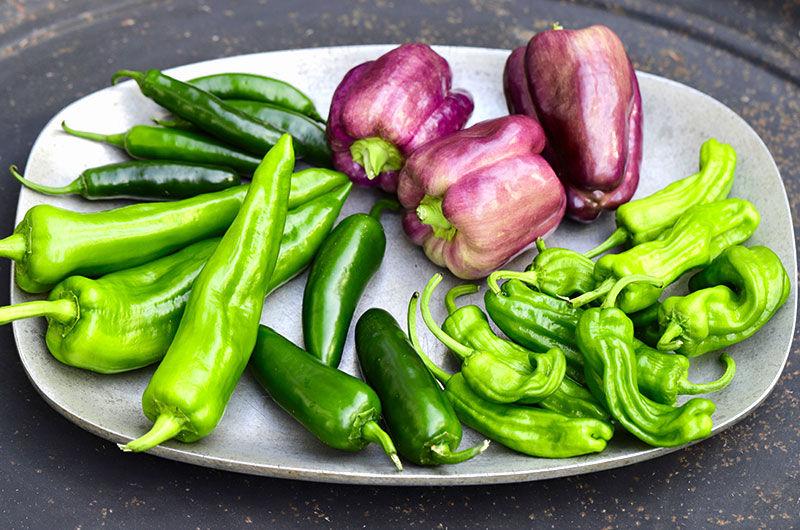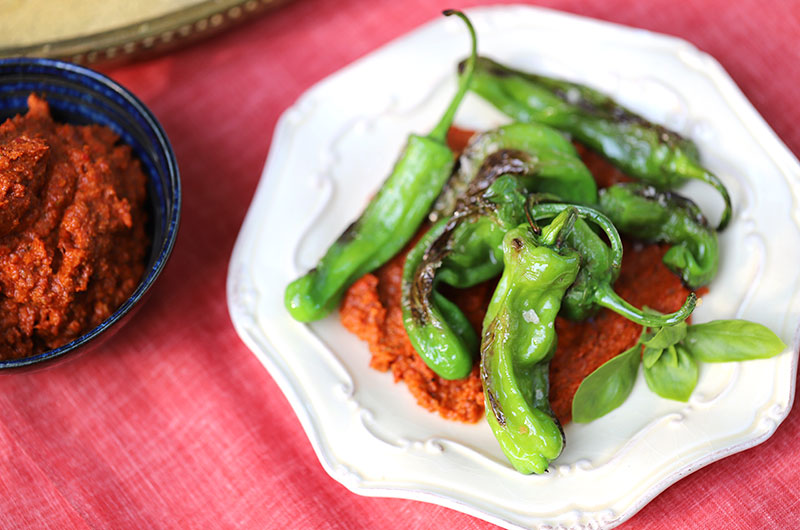When I was a farmer, I waited, and waited, and waited for bell peppers to turn red. It was late September, early October before I’d finally get enough to sell at the farm stand. And by then they had taken up so much space and time in the garden that I couldn’t charge what they were worth. So mostly I just ate them myself.
Or I sold the green peppers as soon as they were full size, not bothering to give them the extra month or so to turn red. By August, peppers would be abundant – especially the small hot varieties like serrano and jalapeño. Once they got going, the plants cranked out the fruit until last frost in late October.
I grew banana peppers (blue ribbon at the fair!), poblanos, and three kinds of sweet peppers: California Wonder, King Arthur, and King of the North. Thanks to Rebecca Gilbert at Native Earth Teaching Farm in Chilmark, I grew an incredibly flavorful pepper called Jimmy Nardello. It’s a crinkly Italian frying pepper that ripens quickly to a deep red color and is fairly prolific. It has the look of a hot pepper, the fruitiness of a sweet pepper, and something very umami-ish to boot.
But by far the most prolific peppers I grew were shishitos, which first came on my radar as a culinary curiosity. I don’t know what year it was, but every chef began “blistering” them (whole) and serving them with sea salt and good extra-virgin olive oil as tapas or a starter. Soon we enthusiastic home cooks followed, tossing our shishitos around hot cast iron pans or in grill baskets.
For a market gardener, shishitos were a dream. Every morning I’d go up and down the row of plants plucking these pendulous peppers by the dozen. (Morning Glory Farm in Edgartown and North Tabor Farm in Chilmark, among others, grow them both for market and for local restaurants).
In the kitchen, instead of just serving them with sea salt, I experimented with putting them on toast with a layer of goat cheese, or creamy feta, or even hummus. I tried them blistered in tacos. But because they are meant to be eaten whole, seeds and all, they don’t really do well in complex preparations or as sidekicks. They like to be the star.
What they really needed, I now realize, is a sauce – but not just any sauce. The moment I understood this was this summer when I saw shishitos on Chef Richard Doucette’s small plates menu at The Covington restaurant in Edgartown. Here was the description: Shishitos. Sun-dried Tomato Romesco. Pine Nuts. Ricotta Salata. Ravece EVOO.
Of course! The pairing is brilliant because romesco is a Spanish tomato and roasted bell pepper sauce, so by serving shishitos with romesco, you get the green, herbaceous flavor of the shishitos (and on occasion, a little heat) with the sweet and earthy flavor of roasted red bell peppers.
To my mind, using two pepper varieties in one recipe is awesome, especially now that our gardens and farm stands are dispensing peppers like PEZ candies. We need help with the bounty, and one can only eat so many pepper jams, pickled peppers, and sausage and peppers.
So back to my kitchen I went to create a romesco-ish sauce for shishitos. I started with a sauce I had developed for my book Fresh from the Farm (Taunton Press, 2014). It’s basically a purée of roasted bell peppers and quick-roasted plum tomatoes. But to make it easier, this time I swapped the roasted tomatoes for sun-dried tomatoes, stealing that idea from Doucette. I also added some roasted almonds, a bit of bread, balsamic vinegar, garlic, and basil to make the sauce more like traditional Spanish romesco.
It was delicious. I loved the consistency and the flavor, and the nutty undertones from the almonds were especially nice with the blistered shishitos. But the leftovers were awesome too on a variety of foods.
You could, of course, hunt down a high-quality romesco in a gourmet store. But that would be no fun and you’d be left with more random peppers to dispatch. If you want to be a card-carrying pepperpalooza patron, make your romesco – and blister your shishitos too.




 2 comments
2 comments



Comments (2)